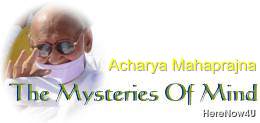
Imagine an unknown man sitting in a dark room for an hour or so. By an analysis of the atmosphere of the room we can establish the identity of the man even after he has departed from the room. Dogs are used in tracing criminals because they can apprehend them with the help of their sense of smell. Scientists have developed a system of smell-analysis. This method is being applied in tracing out criminals. All this is done on the basis of the odour, which the body of the criminal emits. It is said that the bodies of the tirthankaras emitted a sweet odour like that of the red lotus plant. It is supposed to be a special characteristic of the bodies of the tirthankaras. Every living body emits some odour or the other, pleasant or unpleasant. It has been mentioned in ancient works on sex that some women emit an odour similar to that of the pink lotus plant. Such women are called padminis. It has been stated that various arts can be learnt and mastered through the bodies of such women.
Odour flows from the bodies of living beings through their palms, the bottoms of their feet and through their sweat. An odour, which spreads in the atmosphere, gives a clue to the whereabouts of criminals. That is why burglars when they commit burglary wear hand gloves and socks to avoid detection. However, the particles of odour are so subtle that they pass through the texture of the gloves and socks and stick to the floor and walls of the room into which the burglars had entered.
One category of nama karma is what is called gandha nama karma (smell). It is through the mechanism of smell that the odour manifests itself. Other categories of nama karma are:
- rasa nama karma (taste), and
- sparsa nama karma (touch), etc.
We have ceased to be familiar with these concepts. Once it was believed that there is a network of nama karmas:
- atapa nama karma (beat),
- udyota nama karma (light)
- paraghata nama karma (stroke),
- svasocchvasa nama karma (breath)
- sarira nama karma (body buildi ng),
- gati nama karma (motion), etc.
What was the purpose behind this elaborate classification? It may, however, be noted that all these categories of nama karma are connected with the body. If we try to understand this classification with reference to the glands, it will cease to be mysterious.
The glands perform their functions not only in the gross body but also in the subtle body. What happens in the subtle body may be transmitted to the gross body also. The subtle body is the controlling agency of the gross body. It controls breathing. It also controls insight. The function of the sense-organs is also controlled by the subtle body. It also controls the entire energy, which we possess. Our potential for aggression and self-defence are controlled by the subtle body. And all this happens mechanically.
Scientists are familiar with what happens in the gross body, but they are unable to explain why it so happens. Most of our problems will have been solved if we knew that gross body is caused and controlled by the subtle body.
The sarira nama karma builds innumerable kinds of gross bodies. The gross body composed of bones, flesh and blood is one of them.
Then we have the taijasa body (energy), which brings about all the activities of the gross body.
The next is karma sarira, which we have discussed above.
The taijasa body serves as a connecting link between the gross and karma bodies.
When I speak with a microphone before me, the waves of the sound I produce travel far and wide. These waves are transmitted by electricity, which serves as a carrier. Whatever activates the gross body comes from the taijasa body. The subtle and karma bodies will not be able to function without electricity. The taijasa body is an active mass of electricity.
We obtain prana through breath. The karma and subtle bodies will not be able to receive vital breath except through the taijasa body. The taijasa body is a transmission link between the karma and gross bodies. In the same way the energy stored in the subtle body cannot be transmitted to the gross body except through the medium of the taijasa body, which also transmits the powers of language and the mind to the gross body from the karma body. Language, mind and body have the tendency to be yoked to other entities. This yoking takes place when the taijasa body begins to function and carry things from one place to another. Words and their combinations are the result of the yoking of language to the taijasa body. Language, mind and the gross body are material entities. When they become connected with the vital force through the agency of the taijasa body, they become conscious.
Language develops a conscious characteristic through yoga.
Mind becomes conscious through yoga.
The body gains consciousness through yoga.
 Acharya Mahaprajna
Acharya Mahaprajna

